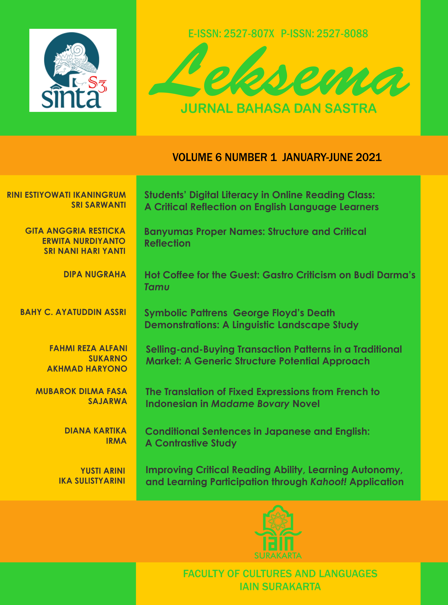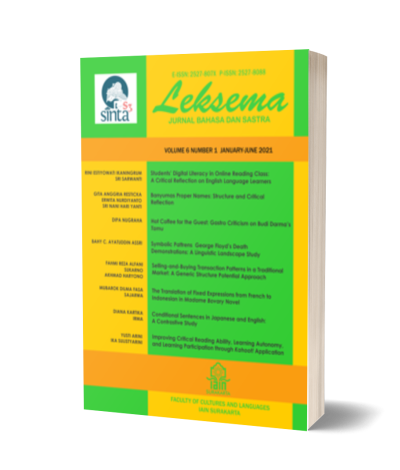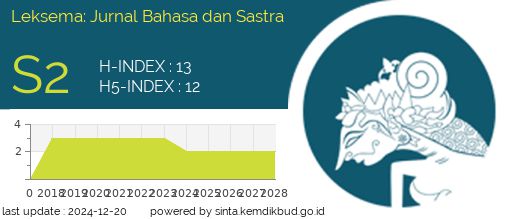CONDITIONAL SENTENCES IN JAPANESE AND ENGLISH: A CONTRASTIVE STUDY
DOI:
https://doi.org/10.22515/ljbs.v6i1.3420Keywords:
English, Japanese, conditional sentence, contrastive analysisAbstract
This research explores the differences in presupposition patterns in terms of conditions and usage similarities between Japanese and English. This paper uses comparative analysis, and the results show that there are some similarities and differences between Japanese and English conditional sentences. First, conditional clauses exist in both conditional Japanese and English sentences and these clauses have two parts: the ‘if-clause’ as the situation and the ‘main-clause’ as the result. Second, conditional sentences in both languages have similarities in that they express the possibilities and suppositions of the speakers. Third, conditional sentences in Japanese comprise 㨠(-to), ã° (-ba), ãªã‚‰ (-nara), and ãŸã‚‰ (-tara) sentences. Fourth, there are three types of conditional sentences in English, namely the conditional that is true in the present/future tense, untrue in the present/future tense, and untrue in the past tense. Fifth, the conditional sentence in Japanese using -to, -ba, -tara, and -nara can all be used inherently in the predicate of the clause.
Downloads
References
Abbas, Mustafa Abbas. 2012. “Conditional Sentences in English and Kurdish: A Contrastive Studyâ€. Al- Fatih Journal 50
Ali, Asem Shehadeh. 2013. “The Verbal System of Malay and Arabic: Contrastive Analysisâ€. International Journal of Business and Social Science 4 (1)
Ali, Faidlal Rahman. 2009. English Grammar. Yogyakarta: Pustaka Widyatama
Al Rdaat, Sadam Haza'. 2017. “An Analysis of Use Conditional by Arab Students of Englishâ€. Advances in Language and Literary Studies 8 (2)
Azar, Betty Schrampfer. 1993. Understanding and Using English Grammar. London: Prentice-Hall, Inc.
Alim, Burhanuddin. 2014. Ayo Belajar Bahasa Jepang. Yogyakarta: Graha Ilmu
Chaer, Abdul. 2006. Tata Bahasa Praktis Bahasa Indonesia. Bandung: Rineka Cipta
Dovaise, Majid Saedi. 2011. “A Phonological Contrastive Analysis of Kurdish and Englishâ€. International Journal of English Linguistics 1 (2)
Kurniawan, Alvian. 2014. Panduan Lengkap Tata Bahasa Jepang. Yogyakarta: Penerbit Sketsa
Mayumi, Kudoo. 1990. Kotaba No Kagaku Gendai Ni Hongo No Judoobun. Tokyo: Mugishoboo
Momani, Mowafaq Mohhamad & Abeer Muneeer Altaher. 2015. “A Contrastive Analysis of English and Arabic from a Syntactical Perspectiveâ€. International Journal of English Literature and Culture. 3(11): 280-284
Nakagawa, Saowaree. 2005. “The Logical Constraction of Conditional Sentence and The Function of Conditional Expression: A Contrastive Study Japanese and Thaiâ€. 15th Meeting of The Southeast Asian Linguistic Society
Puspitasari, Rianny. 2014. Ungkapan Pengandaian ~ã¨; ~ã°; ~ãŸã‚‰; ~ãªã‚‰dalam Bahasa Jepang dan Padanannya dalam Bahasa Indonesia. (S2 Thesis). Bandung: Universitas Pendidikan Indonesia.
Salim, Jamal Azmi. 2013. “A Contrastive Study of English-Arabic Noun Morphologyâ€. International Journal of English Linguistics 3 (3)
Saputra, Aditya R & Bayu S Wipriyanto. 2015. Jago Kuasai Bahasa Jepang. Yogyakarta: Pustaka Baru
Soeparno. 2004. Dasar-dasar Linguistik Bahasa Jepang (Nihongo Gaku no Kiso). Bandung: Humaniora
Soeparno. 2007. Nihongo no Bunpou: Tata Bahasa Jepang Tingkat Dasar. Bandung: Humaniora
Sudjianto & Ahmad Dahidi. 2007. Pengantar Linguistik Bahasa Jepang. Bekasi Timur: Kesaint Black
Sutedi, Dedi & Susi Widianti. 2016. “Kalimat Pengandaian Bahasa Jepang: Kajian Sintaktis dan Semantikâ€. Jurnal Pendidikan Bahasa dan Sastra, 16 (1): 23-32
Tarigan, Henry Guntur. 2009. Pengajaran Analisis Kontrastif Bahasa. Bandung: Angkasa
Tjhin, Thian Shiang. 2016. Fokus Percakapan Bahasa Jepang. Jakarta. Gakushudo
Yamaguchi, Seiko Fujii. 1989. “Concessive Conditionals in Japanese: A Pragmatic Analysis of the S1- TEMO S2 Constructionâ€. Proceedings of the Fifteenth Annual Meeting of the Berkeley Linguistics Society (1989): 291-302
Zarei, Laela. 2014. “Classification of Adjectives in Terms of English and Persian Contrastive Analysisâ€. International Journal of Language Learning and Applied Linguistics World (IJLLALW) 7 (3): 300-313
Downloads
Published
Issue
Section
License
The copyright of the received article shall be assigned to the publisher of the journal. The intended copyright includes the right to publish the article in various forms (including reprints). The journal maintains the publishing rights to published articles.
In line with the license, the authors and users (readers or other researchers) are allowed to share and adapt the material only for non-commercial purposes. In addition, the material must be given appropriate credit, provided with a link to the license, and indicated if changes were made. If authors remix, transform or build upon the material, authors must distribute their contributions under the same license as the original.







